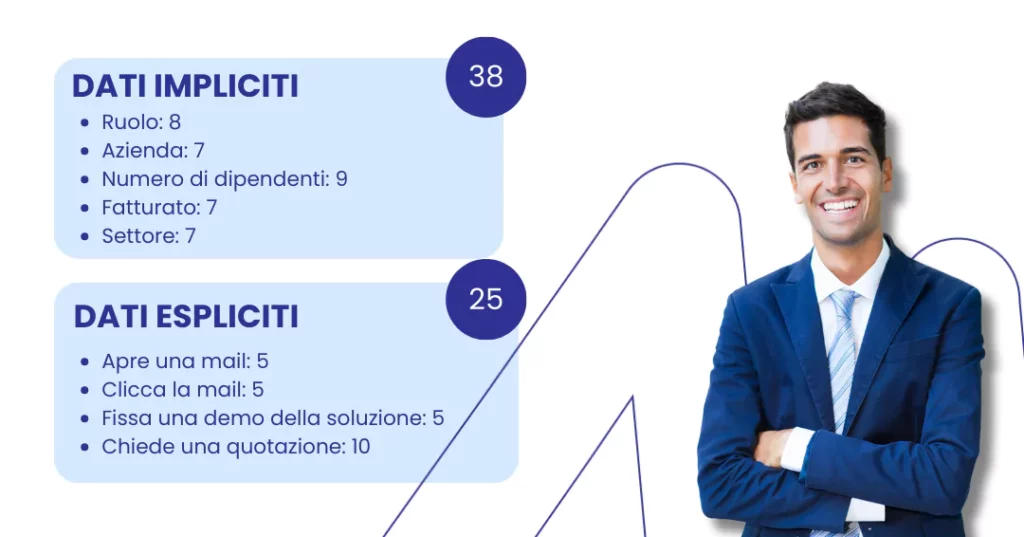In this article we will try to answer some of the main questions that revolve around the concept of Lead Scoring, with particular reference to the world of B2B.
Introduction
When designing a new marketing strategy to promote our company’s products or services, there are essentially two questions to start with: we need to ask ourselves how to generate new target contacts (i.e. potential buyers) and >how to qualify these leads for sales. And this article we will focus on the second.
We have heard it said many times: “it is not so much the number that matters but the quality of contacts”. When we talk about Lead Scoring we are referring precisely to this: qualification criteria for a new contact who, naturally, has expressed an interest in one of the communication channels of our digital ecosystem.
What is Lead Scoring?
First of all, let’s start from a scientific definition of Lead Scoring:
This is a methodology used to classify potential customers, based on a scale that represents the perceived value that each lead represents for the company.
Wikipedia
We could talk about a real marketing tool; i.e. an evaluation methodology that assigns a score to a contact based on various criteria.
Its purpose is therefore to classify potential customers, so as to automatically identify the most promising ones and discard (i.e. disqualify) non-target contacts.
Criteria for evaluating a Lead
The qualification criteria for a Lead may vary based on the company’s business. However, there are macro-areas that all organizations could take as a reference for their internal processes.
There are two main macro criteria, both of which concern the data collected during the acquisition of the new contact:
Explicit data: this is information generally deriving from filling out a contact form, in which you are asked to leave your data regarding Name, Surname, Email and telephone number, role, name, sector and size of the company you belong to;
- Implicit data: these are behavioral data. We collect information on the opening / clicking of email communications sent to the contact, if he has downloaded content, if he has visited web pages or, more simply, if he has responded to our phone calls after completing the form;
In both cases, this is extremely valuable information that contributes to the qualification of a Lead.
So, before we start assigning a specific score to leads, we need to establish our criteria; criteria which must be based on indicators which can indicate a greater or lesser propensity to purchase our products or services.
Lead Scoring Examples
Once we have defined that Lead Scoring serves, in a very practical way, to assign/remove points from contacts stored in the database, let’s look at some practical application examples together.
Example:
Carlo Rossi is a Marketing Manager of a B2B company, looking for marketing automation software capable of integrating with the CRM and the website of his organization that operates in the sector of solutions and services for marketing. ‘HR. He was asked to make a software selection and to propose a short list of solutions, including ours.
Di Carlo, we therefore have the following information, to which we can assign a score ranging from 1 to 10:
- Role: 8;
- Company: 7;
- Number of employees: 9;
- Turnover: 7;
- Sector: 7;
TOTAL explicit data: 38.

Furthermore, after requesting information, Carlo carries out the following actions in chronological order:
- Opens an email: 5;
- Click the email: 5
- Schedule a demo of the solution: 5;
- Ask for a quote: 10;
TOTAL implicit data: 25.
Based on our Lead Scoring criteria, we may or may not qualify Carlo as a potential customer ready to sell the proposed solution.
Lead Scoring and CRM strategy
Scoring leads is essential for those companies in which Marketing and Sales work in synergy. In this post, we have already addressed the topic of integrating CRM and Marketing Automation< /strong>, but let’s take a look at some essential advantages here.
Certainly, this system allows us to save time: the qualification of a contact is automatic. Furthermore, we are able to collect so much information which is very useful in terms of segmenting our contacts (targets for various types of campaigns).
Conclusions
Now that we have understood how important Lead Scoring is, all that remains is to “get our hands dirty”. Implementing processes of this type in the company requires time and a certain sensitivity on the topic. But the effects are absolutely beneficial.
If you want to delve deeper into these topics, or if you are looking for a Marketing Automation solution… do not hesitate to contact us here.








